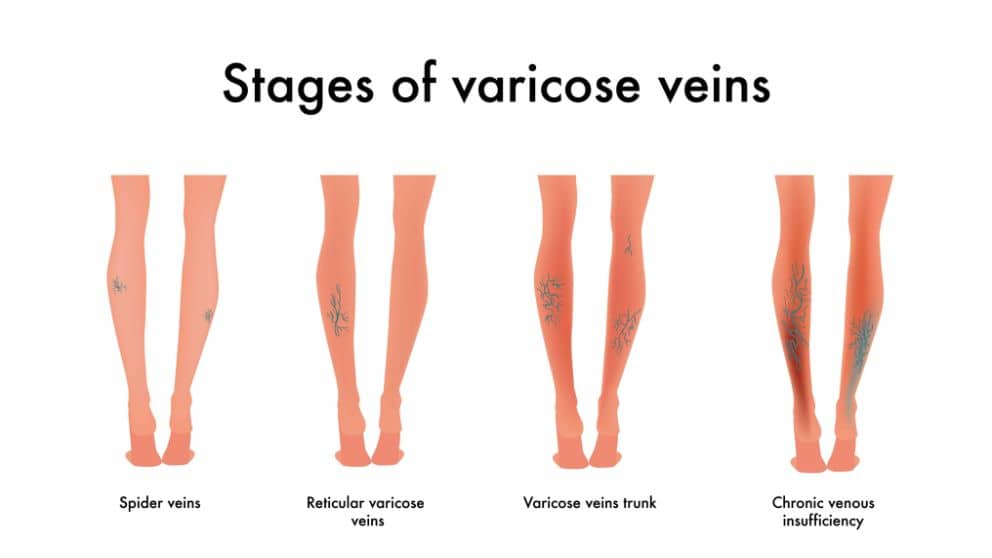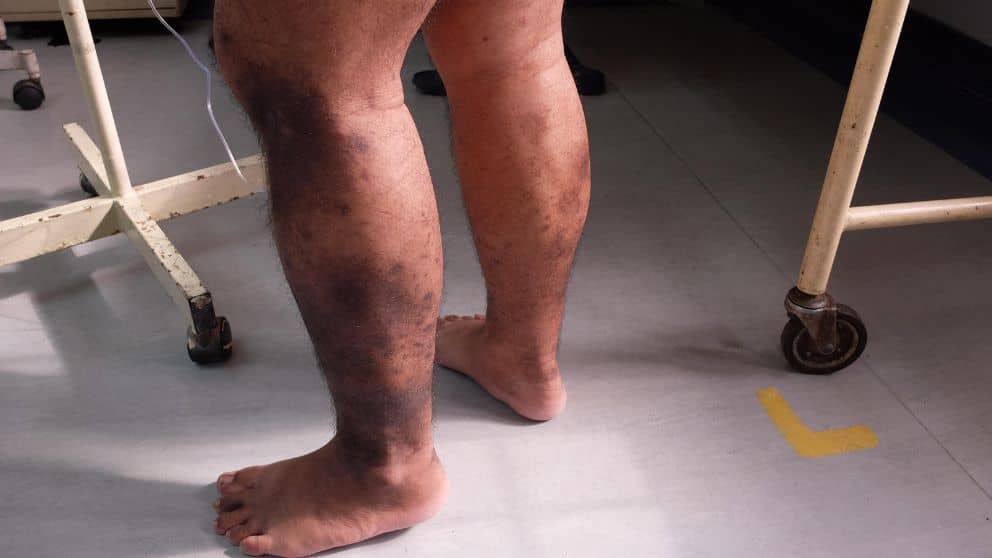Chronic venous insufficiency (CVI) is a common circulatory disorder that affects millions of people in the United States. It can develop from a combination of factors, including damage to the veins, increased pressure on the veins, and problems with the valves in the veins.
Table of Contents
ToggleWhat Is Chronic Venous Insufficiency?
Chronic venous insufficiency occurs when veins can no longer return blood to the heart and so pressure in the veins builds up (venous hypertension) and fluid accumulates in the tissues. This can cause pain, swelling, and a feeling of heaviness in the legs. In severe cases, CVI can lead to skin ulcers and even gangrene.
What Is the Difference between the Superficial and Deep Venous Systems?
The superficial veins are located close to the surface of the skin, while the deep veins are located further down in the body. The two systems work together to return blood from the extremities back to the heart. Both systems can lead to chronic venous insufficiency and are treated differently.
What Causes Chronic Venous Insufficiency?
Damaged superficial veins are the primary cause of chronic venous disease. Processes that damage the superficial venous system and lead to CVI, include:
- Damage to the veins caused by injury, surgery, or radiation therapy
- Vein problems such as varicose veins
- Increased pressure on the veins due to obesity, pregnancy, or prolonged sitting or standing
- Problems with the valves in the veins that keep blood flowing in the right direction
As a result of any of these factors, the veins can become weak and unable to function properly.
Occassionally preblems in the deep veins lead to chronic venous insufficiency with major factors being:
- failure of the venous valves: causing venous reflux
- deep vein thrombosis: blocking overall blood flow back to the heart
- May Thurner syndome
These cause increased venous pressure. May Thurner syndrome also called “left sided iliac compression syndrome” is a condition in which the main left vein (the iliac vein) is compressed by the overlying right common iliac artery. This leads to increased pressure in the left side of the body and can cause CVI.

What Are the Risk Factors for Developing Chronic Venous Insufficiency?
Some of the risk factors for CVI include:
- Age: The risk of developing CVI increases with age.
- Gender: Women are more likely to develop CVI than men.
Smoking: Smoking increases the risk of developing CVI. - Obesity: Being overweight puts pressure on the veins and increases the risk of CVI. Maintain a healthy body weight.
- Pregnancy: Pregnancy can increase the risk of CVI because the weight of the baby pushes on the veins in the mother’s pelvis.
- Sedentary lifestyle: A sedentary lifestyle increases the risk of CVI because it leads to increased pressure on the veins.
- Family history:
What are the Symptoms of Chronic Venous Insufficiency?
Symptoms of CVI vary from person to person and can range from mild to severe. They may include:
- Swelling in the legs and ankles
- Heaviness or fatigue in the legs
- Swollen feet
- Aching or cramping in the legs (venous claudication)
- Brown patches on the skin of the lower leg (due to accumulation of blood)
- White or blue veins near the surface of the skin
- Burning, itching, or tingling in the legs
- Painful leg cramps
- Venous leg ulcers (venous stasis ulcers)
- Gangrene
Chronic venous insufficiency (CVI) can also be a cause of restless legs syndrome.
What is Stasis Dermatitis?
Stasis dermatitis is a type of skin inflammation that can occur in people with CVI. It is caused by the build-up of fluid and blood in the tissues, which can damage the skin. Symptoms include red, swollen, itchy skin, as well as blisters and sores.
How is Chronic Venous Insufficiency Diagnosed?
The diagnosis of CVI is based on a physical examination and a review of your medical history. Imaging tests, such as Duplex ultrasound or MRI, may be used to help identify the cause of the problem.
What are the Stages of Chronic Venous Insufficiency?
There are five stages of chronic venous insufficiency:
Stage I: Mild symptoms with no skin changes
Stage II: Swelling, aching, and cramping in the lower legs
Stage III: Skin changes such as brown patches and swollen veins
Stage IV: Open sores (ulcers) on the leg
Stage V: Gangrene and loss of limb
Treatment for chronic venous insufficiency depends on the stage of the disease. In most cases, lifestyle changes such as exercise, weight loss, and avoidance of prolonged sitting or standing are recommended. Compression therapy may also be indicated. In more severe cases, “pinhole” procedures and even vascular surgery may be required.

What are the Treatments for Chronic Venous Insufficiency?
Chronic venous insufficiency can be a very debilitating condition, but there are many treatments available. There is no one-size-fits-all treatment for CVI, but common therapies depend on the source is the superficial system (the more common) or deep. What are treatments for chronic venous insufficiency (CVI) caused by the SUPERFICIAL venous system.
Treatments aim to relieve venous congestion, decrease high venous pressure by improving blood flow to the heart and relieving blood pooling the legs.
- Lifestyle changes such as losing weight, exercising regularly, and avoiding prolonged sitting or standing
- Compression stockings or wraps to help reduce swelling and improve blood flow
- Lymphedema therapy to help reduce fluid accumulation
- Anticoagulants (blood thinners) to prevent blood clots
- Sclerotherapy to close off damaged veins
- “Pinhole” procedures to close of the damage vein using miniaturized devices inclusing laser and radiofrequency
- Surgical treatment to repair or remove damaged veins (vein stripping or ligation) What are treatments for chronic venous
Surgical treatment to repair or remove damaged veins (vein stripping or ligation) What are treatments for chronic venous insufficiency (CVI) caused by the DEEP venous system.
- Lifestyle changes such as losing weight, exercising regularly, and avoiding prolonged sitting or standing
- Compression stockings or wraps to help reduce swelling and improve blood flow
- Anticoagulants (blood thinners) to prevent blood clots
- “Pinhole” procedures to remove deep vein thrombosis or to place a stent to keep a vein open including May Thurner syndome.
- Surgery to for vein bypass, repairing valves or removing DVTs
Deep vein thrombosis is a serious health threat and should be treated promptly.
How Do the Physicians at Imaging & Interventional Specialists Diagnose Chronic Venous Insufficiency?
The physicians at Imaging & Interventional Specialists will start with a comprehensive history and physical exam. Then they may use the latest technology to diagnose chronic venous insufficiency. This includes Duplex ultrasound, CT aand magnetic resonance venography and conventional venography of you leg veins. We also use these technologies to help guide treatment for CVI and to determine how your blood flows in both you superficial system and deep system. In this way a personalized treatment plan can be created for your exact situation.
What “Pinhole” Procedures Do the Physicians at Imaging & Interventional Specialists Use to Treat Chronic Venous Insufficiency?
Imaging & Interventional Specialists will determine which non-surgical vascular interventional radiology (VIR) procedures can address your situation and to develop a comprehensive treatment plan. Treatments can include:
For the superficial system:
When the deep system is open closing off problem areas of the superficial will increase blood flow via the functional deep system therefore decreasing venous hypertension and relieving symtpoms.
Supervicial veins can be closed off with:
radiofrequency ablation
endovenous laser treatment
sclerotherapy
Deep venous system problems are much less common and involve treating blockages that may result from vein narrowing or from blood clots blocking blood flow in the affected vein.
- DVT (blood clot) treatment – clot busting drugs, clot maceration, clot aspiration
- stent placment
- IVC or SVC filter placement: preventing deep vein clots from reaching the heart and causing a potentially life threatening pulmonary embolism.
What Are the Advantages “Pinhole” Procedures Performed by Imaging & Interventional Specialists to Treat Chronic Venous Insufficiency?
Every day our interventionalist successfully perform “pinholes” offering this region world class, state-of-the-art solutions to hronic venous insufficiency. Our non-surgical image guided procedures are cutting edge technology without the cutting, without the scalpel. You leave with a Band-Aid!
- Procedures performed in a comfortable outpatient setting with familiar friendly staff
- fast recovery,
- less risk, and
- less pain

Why Imaging & Interventional Specialists?
Imaging & Interventional Specialists are leaders in interventional radiology and experts in the non-surgical procedures that will address your chronic venous insufficiency.
Using state-of-the-art equipment, our experienced board-certified specialists are focused on your best outcome.
It is important to determine what is causing your chronic venous insufficiency and to treat these causes since CVI is associated with ulcers, deep vein thrombosis for examples.
At IMAGING & INTERVENTIONAL SPECIALISTS board-certified physicians offer in-house testing to determine the cause and develop an individualized treatment program for your chronic venous insufficiency.

